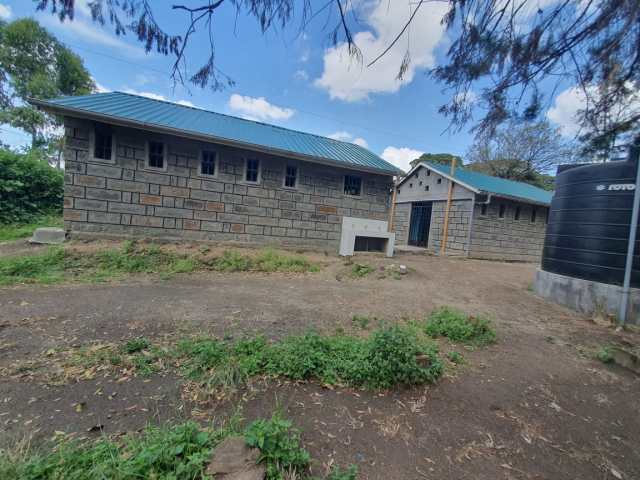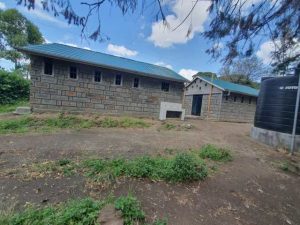Rurii school’s bio-latrines pave the way for Kabatini Aquifer conservation

Rurii Primary School in Nakuru County is charting a new path in environmental sustainability through an innovative initiative that seamlessly integrates sanitation, energy efficiency, and water conservation.
At the heart of this transformation are bio-latrines that convert human waste into biogas for cooking. This solution not only curbs reliance on firewood but also safeguards the Kabatini Aquifer, a crucial water source for Nakuru City.
This groundbreaking initiative forms part of a larger mission to promote sustainable water resource management in a region where 90 per cent of the water supply is derived from underground sources, particularly the Kabatini Aquifer.
Backed by the Catchment to Tap (C2T) Project Consortium comprising WWF-Kenya, Egerton University, and the Kenya Water and Sanitation Civil Society Network (KEWASNET) and funded by the Embassy of the Kingdom of the Netherlands, the project exemplifies the impact of collective action in conservation.

The Kabatini Aquifer, like many underground water sources, faces growing threats from contamination and over-extraction.
By installing biodigesters at the school, these risks are mitigated while simultaneously offering clean, renewable energy. Vitens Evides International (VEI), a C2T partner, has spearheaded the construction of these eco-friendly toilet blocks, providing an affordable and sustainable waste management solution for the community.
Further complementing these efforts, Nakuru Water and Sanitation Services Company Ltd (NAWASSCO) has received a Ksh 13 million grant under the C2T project. This funding aims to protect critical water sources, including two springs, and advance the gazettement of the aquifer to ensure its long-term sustainability.
Beyond protecting the aquifer, Nakuru is embracing the “sponge city” concept, a forward-thinking approach designed to capture and store rainwater for future use.
This strategy not only mitigates flooding risks but also ensures a reliable water supply during dry spells, presenting a cost-effective and sustainable solution.
Aligned with these water conservation strategies, sustainable land-use practices such as terracing, contour farming, and transitioning from subsistence farming to agribusiness are being promoted. These measures aim to reduce soil erosion, improve water retention, and enhance agricultural productivity, ultimately contributing to poverty alleviation and food security in the region.
During a media workshop organized by WWF-Kenya and its partners, Professor Engineer Japheth Onyando from Egerton University underscored the urgent need for integrated groundwater management.
He called for the collective stewardship of water recharge areas and water towers while emphasizing the importance of regulatory frameworks to address over-extraction risks, particularly through proper borehole spacing.
Similarly, Dr. William Ojwang, WWF-Kenya’s Freshwater Scientist, highlighted the pressing need for effective water management in Kenya, a water-scarce nation.
He emphasized the importance of protecting catchment areas as a sustainable solution to ensure long-term water security amid increasing population and economic pressures.

KEWASNET CEO Malesi Shivaji further detailed critical conservation measures for the Kabatini Aquifer.
These include removing invasive tree species, re-vegetating sub-catchments with indigenous trees, promoting alternative livelihoods to reduce farming within the aquifer area, and installing rainwater harvesting systems to reduce dependence on groundwater.
He also emphasized restricting harmful practices such as charcoal burning and grazing, which degrade the ecosystem.
In addition, Shivaji noted that efforts to monitor and manage the aquifer are also underway, including capacity-building programs, groundwater and rainfall monitoring, water quality assessments, and the creation of a comprehensive database to track conservation progress.
“These actions underscore a commitment to ensuring the aquifer’s sustainable use and protection,” he noted.

The media workshop and field visit, supported by the C2T technical team, sought to amplify awareness of the importance of safeguarding underground water sources in urban areas like Nakuru.
The initiatives in Nakuru exemplify the transformative potential of collaborative and innovative approaches to natural resource management.
From bio-latrines and sponge city strategies to sustainable farming and integrated groundwater management, Nakuru is paving the way for addressing complex energy, water, and agricultural challenges while conserving essential resources.
Through its unwavering commitment to sustainability and partnerships, the region is crafting a future where communities, businesses, and the environment thrive together in harmony.
The post Rurii school’s bio-latrines pave the way for Kabatini Aquifer conservation first appeared on KBC.
The post Rurii school’s bio-latrines pave the way for Kabatini Aquifer conservation appeared first on KBC.


